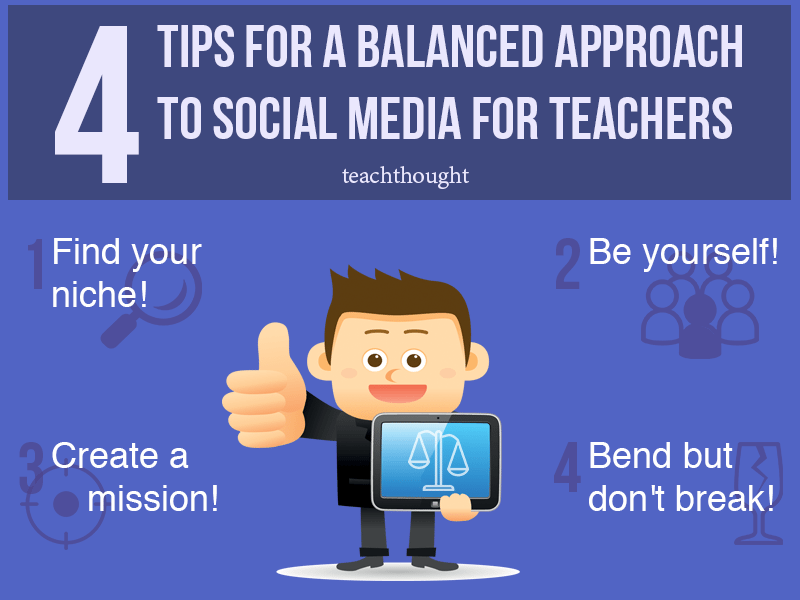
Social Media For Teachers: A Balanced Approach
by Laura Farmer
Sitting at night, in front of my computer, I look at my image on Twitter. I skim through all my hundreds of tweets. Suddenly, I start to panic. What am I doing? I feel like a fake, a phony. I flip over to my description, and read it slowly. It states, I’m an innovator, passionate about technology, and leadership. Am I any of those things, really? Is Twitter just an illusion to make me feel better about myself or get more followers?
Thoughts race through my mind, and suddenly, I type in the key words–social media and narcissism–in the Google search engine. I skim through the articles, “Yes…yes….yes…that is me!” I am an overly self-involved person who only thinks of ways to promote myself! So, I decide immediately to disengage from all media: Facebook, Blogger, and yes…even Twitter.
Call it a moment of weakness, an identity crisis, or just plain craziness, in that moment it all made sense.
Over the next week, social media free, I reevaluated. My theory? A bad case of social media overload. Once summer break began, I constantly read the latest and hottest trends in education through blogs and twitter feeds regarding innovation, technology integration, and leadership. In some misguided way, I began to feel that I needed to be passionate about all of those elements to be a great teacher. Of course, I was wrong. It was too much, and I’d lost site of what I was best at.
So, how do we stretch ourselves, as educators, without losing our educational identity, or our minds for that matter? How can we improve without driving ourselves crazy, going numb, or unplugging completely?
4 Tips For A Balanced Approach To Social Media For Teachers
1. Find a niche
First, let’s keep it focused. Instead of trying to be all things innovative, maybe we should try focusing on learning one new technology for next year. Spend time researching that for the summer, so it can be great. Vicky Davis, on Twitter @coolcatteacher, has a fantastic blog with loads of ideas. Studying her contributions alone could set the course for a more innovative year. @teachthought focuses on rethinking how people learn in light of modern technology. #edutopia focuses on project-based learning.
Whatever example you follow, choose a niche and be great at it.
2. Be yourself
Secondly, know that it’s okay to be you. Spending time on Twitter overwhelms most teachers that I’ve worked with, novice and veteran. It’s important to know that you don’t have to identify with any particular #(hashtag) to be a great teacher. However, we shouldn’t give up on developing a professional learning network (PLN) through Twitter altogether. Twitter is a great way to network, and learn from other educators who share similar passions and interests. It helps to keep the creativity going in the classroom.
3. Create a mission
Ask yourself, what would I like to learn from Twitter? What is my purpose? Write down a few ideas, and then narrow it to one particular theme such as technology or a content area. Then, go ahead and open an account, write a brief description or none at all. Next, set a time limit every day at the same time during the day. Personally, I’ve limited my Twitter reading to the morning for 15 minutes, and evening for 30 minutes. It keeps me focused on my learning, and limits my tweets. Additionally, stay focused on following only the educators who will help you stretch according to your mission as a teacher. Don’t follow someone just because he or she is popular, stick with your personal learning mission.
4. Bend but don’t break
Finally, stretch your educational pedagogy–bend, but don’t break. By taking on and reading too much, too soon, you risk turning your already enriching curriculum on its head, and your passion for teaching in the process. Start small, don’t worry about keeping up with the proverbial Joneses of classroom technology innovation, and pick one technology to add flair to the curriculum you’ve developed over your career.
Take a deep breathe, and know that you are a fabulous teacher; the methods work. Just find one way to stretch it further for the upcoming school year, and you’ll be ahead of the curve.
Laura Farmer is a middle grades teacher in Newnan, Georgia, who loves teaching, and considers it a privilege to be part of the educational community. She blogs her joys, struggles, and discoveries of the classroom at middlegradesteacher.blogspot.com. She can be followed on Twitter @happyeducators.
